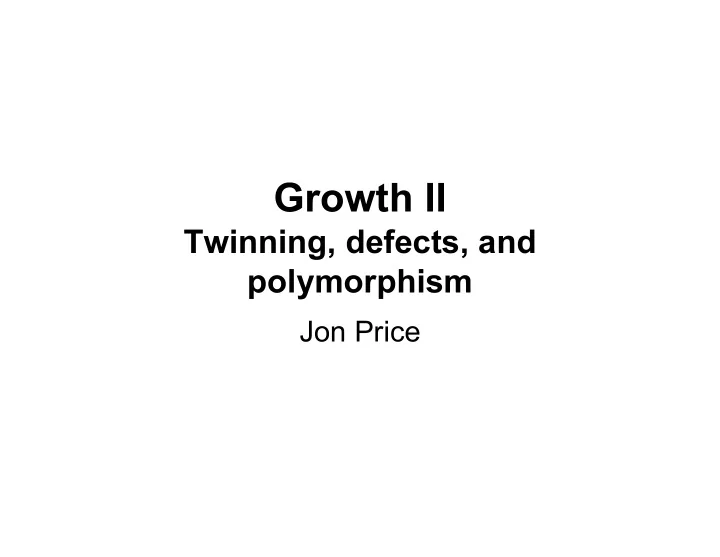

Growth II Twinning, defects, and polymorphism Jon Price
� ongratula � on � …i ��� twins! Rational, symmetrical intergrowth of structures This raises the internal energy � hromi � � ontac � • Growth twins - free growth accidents, where � win � a lattice becomes offset during nucleation • Transformation twins - movement of parts of the lattice when internal symmetry changes •These may be contact (planar face) or penetration (throughgoing) twins. • Gliding twins - offsets in the lattice as a strain � tauroli � (in response to a stress). Polysynthetic � ene � a � on twin �
Common Twin Laws Triclinic Albite twinning: plagioclase feldspars (CaAl,NaSi)AlSi 2 O 8 commonly show b -axis perpendicular polysynthetic twinning http://open-adit.com Pericline twinning: microcline, KAlSi 3 O 8 , develops twining around the [010] axis when it transforms from a monoclinic structure X-polar photomicrograph by K. Hollocher, Union
Common Twin Laws Monoclinic Manebach twinning: orthoclase, KAlSi 3 O 8 , contact twin. Very common. Formed from accidental growth. Carlsbad twinning: orthoclase and sanidine, KAlSi 3 O 8 , develop penetration twining around the [001]. Formed from accidental growth. Baveno twinning: orthoclase, KAlSi 3 O 8 , develops contact twin during accidental growth. http://open-adit.com
Common Twin Laws Monoclinic Swallow tail twinning: gypsum, CaSO 4 2H 2 O , develops contact twin during accidental growth. Tetragonal Most are cyclical contacts on {011}. Rutile (TiO 2 ) and cassiterite (SnO 2 ) are examples. http://open-adit.com
Common Twin Laws Hexagonal Calcite twinning: Common contact twins are {0001} and rhombohedron. The right from can also can be stress Induced. Brazil twinning and daupine twinning: Penetration quartz twins resulting from transformation. http://open-adit.com
Common Twin Laws Isometric Spinel twinning: contact twin parallel to an octahedron common to spinel (MgAl 2 O 4 ) Iron cross twin: Pyrite (FeS 2 ), 2/m class, may have pentration twinning of the forms with appearant 3A 4 symmetry. http://open-adit.com
Defects Missing atoms (vacancies) Impurities Edge dislocations Screw dislocations Interlayered structures Twins
Non-stoichiometric atoms Schottky defect Image from Perkins, 1998
Edge defect Frenkle defect Image from Perkins, 1998
STM image of PtNi alloy edge defects Michael Schmid, IAP/TU Wien Edge defect AFM image of growth Screw spiral on graphite along dislocation [001]. MIT
Importance of defects Incorporation of non-stoichiometric elements (non substitution) Color Incorporation of foreign materials inclusions Can produce diagnostic characteristics Twinning in feldspar
Energy Minimization Everything explained in the course thus far is the result of energy minimization! Examples? In nature, energy is the only commodity.
Energy Minimization - a system will assume a state of minimum energy. Parameterizing energy - the Gibb’s Free Energy equation G = E + PV - TS E is a measurement of lattice energy, or the sum of bond energy P is pressure V is molar volume T is temp S is entropy note: E + PV = H
So Free Energy is dependent on: 1. The nature of the bonding 2. Pressure 3. Temperature 4. Degree of disorder
The Carbon System Graphite - steep dG/dP Diamond - higher initial G, shallow dG/dP
Diamond’s excited state Image modified from Zoltai and Stout, 1984
Poly morph - ���� µ ��� many forms These abound in Earth Materials and can be of great use in pinning down the conditions at which the mineral formed.
Why can we observe graphite and diamond at the same time? There is a place where both phases share the same G, but at room T, this is ~14 kbar!
At P = 5 kbar
Image from Pauling, 1970
Phase Diagram Recall that as you go into the Earth, both P and T increase These two variables control phase stability of compositions in the earth. On the left is a map for phases of carbon
Reconstruction vs. displacement Displacement requires less transition energy because lattices are just “tweaked” Reconstruction requires substantial excess energy to move things to new configuration
Polymorphs
From Blackburn & Dennen, 1998
Silica Polymorphs
More ‘morphs AlSiO 5 CaCO 3
Order-disorder Reorganization of atoms into more ordered arrangements Decrease in T produces higher order G = E + PV - TS Change in structure accompanies change in order.
Alkali Feldspar Order-disorder T M T
Polytypism Polymorphs that differ only in the stacking of identical, two-dimensional sheets or layers. Cell dimensions parallel to sheets are identical Spacing between sheets is related by multiples .
1. Increasing P results in structures with high densities and large CN are favored 2. Increasing T favors low density and CN 3. High-T modifications often has highest symmetry
In summary - Polymorphism is a reconfiguration of chemical components in response to changing energy. Polymorphs therefore have the same composition but differing structures.
Recommend
More recommend